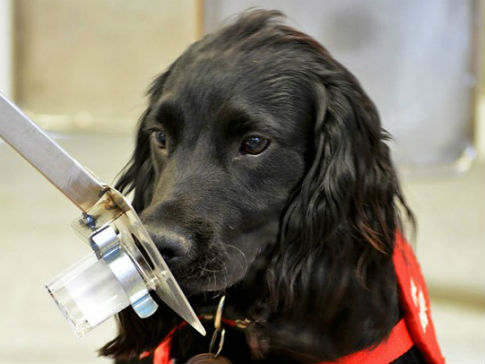Professor Mel Greaves is Director of the Centre for Evolution and Cancer here at The Institute of Cancer Research in London. Here he discusses his recent trip to a kennels to watch the peculiar use of dogs – and their highly evolved sense of smell - in cancer diagnosis.

Smelling, via olfactory receptors, is one of the key senses for many animal species – used to identify and locate food sources, predators and potential mates. The specificities and sensitivities involved can be extraordinary. A male Bombyx moth can smell a female up to 1 km away, given wind in the right direction, down to the level of a single pheromone molecule.
Dogs can similarly detect specific odours at remarkably low levels – down to one in a trillion for some chemicals – hence their widespread use for detecting explosives, drugs and individual people. Dogs have around 300 million olfactory receptors in their nasal passages compared with some 3 million in humans.
Perhaps then we shouldn't be surprised that it appears that dogs can be trained to smell cancer. Since 1989 there have been a handful of anecdotal or small-scale controlled studies claiming that dogs can identify the presence of cancer-derived volatile products in breath, blood, urine or faeces. It might be tempting to put these in the amusing anecdotes basket along with such tales as opera music can help mice survive heart transplants. But that would do an injustice to the story.
At the end of July, I was invited to visit the Medical Detection Dogs (MDD) unit near Milton Keynes, where the Director, Dr Claire Guest, and her colleagues presented a summary of their latest data and demonstrations of the capacity of trained dogs to pick out a cancer patient’s urine sample from a mix with normal controls. The dog walks round in a circle to smell each sample, taking only half a second to either move swiftly along to the next sample (if a control was sniffed) or to sit down and stare, transfixed, if a cancer sample was detected. Much quicker (and more captivating) than any pathologist’s test.
The study now involves an appreciable size of several hundred samples tested and the result is impressive, with around a 95% detection rate for bladder and prostate cancer with a very modest false score rate (~5%). The dog we saw diagnosing a kidney cancer sample was trained (by food reward) on a bladder cancer sample, suggesting some general property of cancer cells’ metabolism might be involved.
There is a great deal as yet unclear - the sensitivity of detection, the relationship to stage of disease and the volatile chemicals involved - but the results so far look impressive. It costs around £10,000 to train a dog and it is difficult to imagine rolling out this programme with kennels at The Royal Marsden and elsewhere.
One clear inference though is that one might be able to do essentially the same thing with analytical chemistry techniques such as gas chromatography or mass spectrometry. And coincidentally, at the recent joint meeting of the ICR and MRC Clinical Sciences Centre at the Hammersmith Hospital, Dr Zoltan Takats presented striking data of a surgical device that samples volatile aerosols from surgical excisions that can, within seconds, deliver a cancer cell specific signature to guide surgeons in delineating the boundary of the cancer.
The MDD unit is collaborating with scientists at The Open University to see how well dogs do compared with what they call an ‘electronic nose’ – based on mass spec. It will be interesting to see the outcome.
In the meantime, other applications of sniffer dogs are even more impressive and indeed life-saving. Some 50 dogs to date have been trained so far in the UK to smell falling sugar levels in hypoglycaemic patients with severe type I diabetes. This can lead to interventions to prevent life-threatening attacks and comas.
Woof, woof, eh?
comments powered by